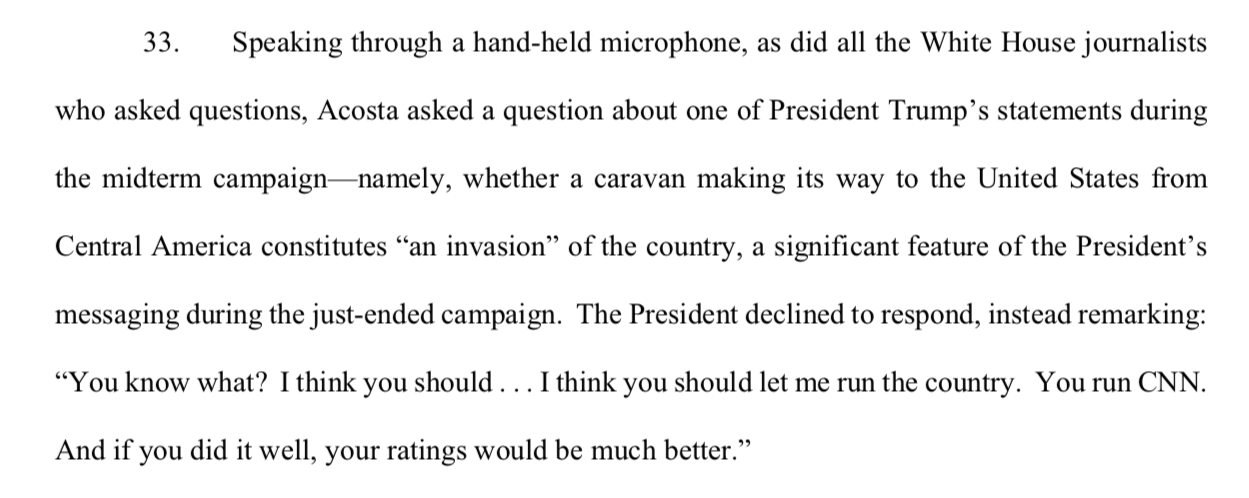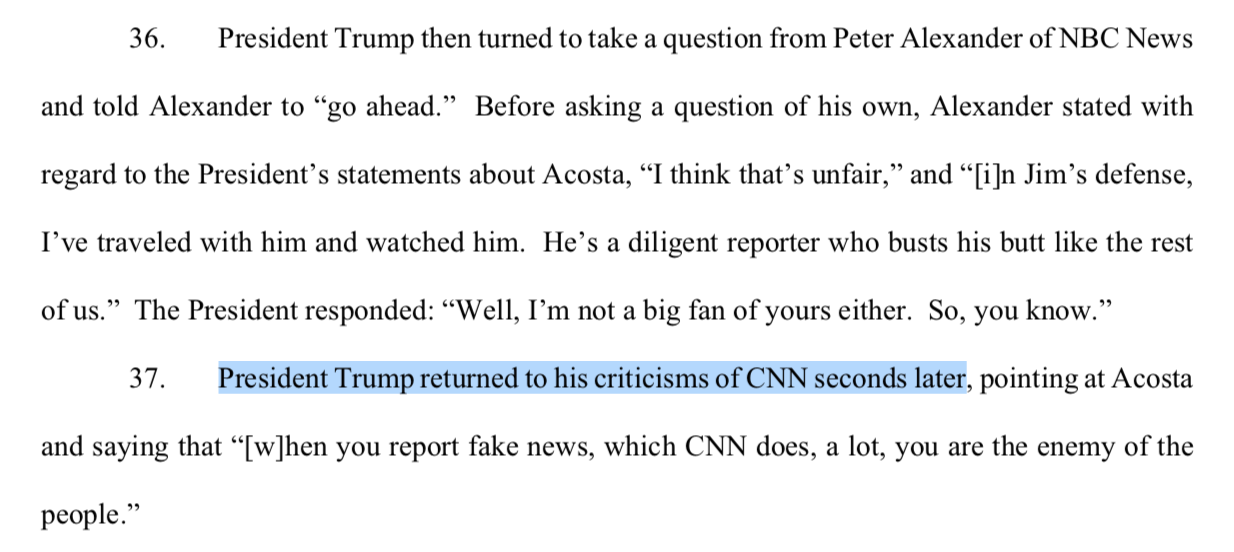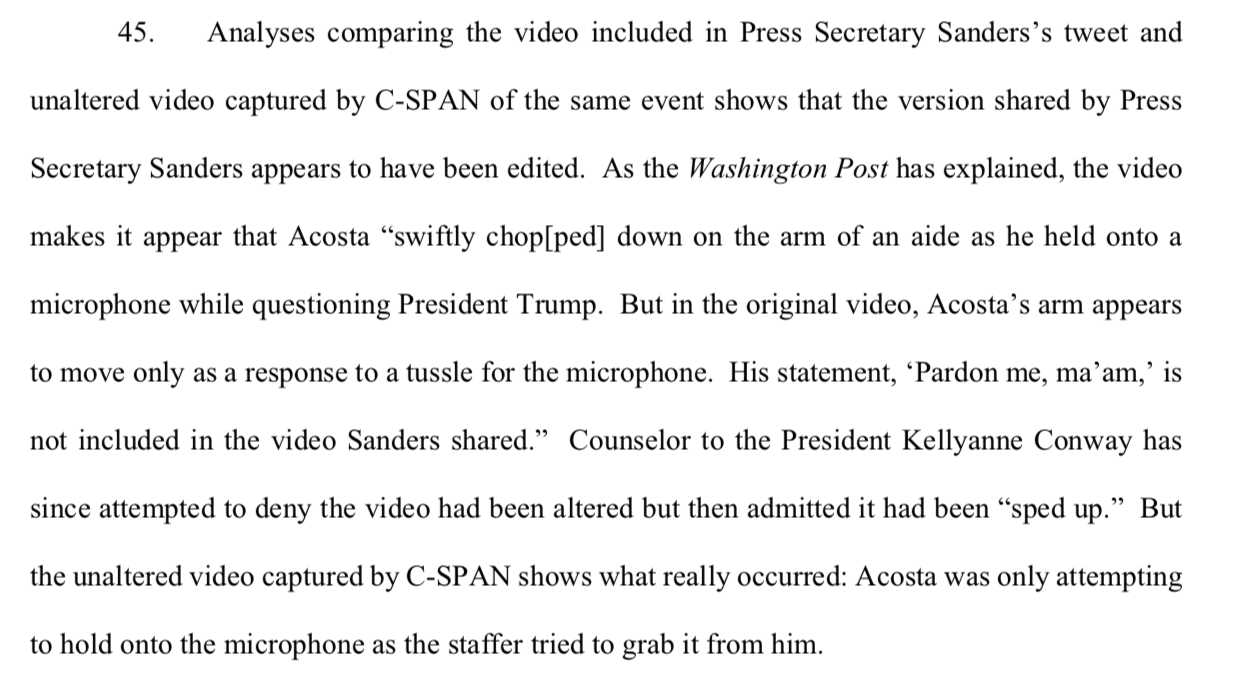CNN and Jim Acosta’s lawsuit against the White House, which alleges First and Fifth Amendment violations, contains several factual inaccuracies.
CNN announced Tuesday morning that it was filing suit against the White House for revoking Chief White House correspondent Jim Acosta’s hard press pass.
The White House took Acosta’s pass last week after a contentious exchange with President Donald Trump during a post-midterm press conference. When a White House intern tried to pass the microphone to the next reporter, Acosta physically prevented the intern from taking the microphone.
In the official lawsuit, CNN makes several errors in its recounting of the events of the press conference that led to the revocation of Acosta’s pass.
1. Mischaracterizes Acosta’s Questioning
In point 33 of the lawsuit, CNN claimed that Acosta started his exchange with “a question about one of President Trump’s statements during the midterm campaign — namely, whether a caravan making its way to the United States from Central America constitutes ‘an invasion’ of the country.”

CNN Lawsuit Against WH (Screenshot)
Video of Acosta’s line of questioning showed that he first promised to “challenge” the president and gave his own opinion that it is incorrect to characterize the caravan as an invasion. He finally asked why Trump called the caravan an invasion.
CNN also claimed that the president “declined to respond” in this point — except Trump responded to Acosta by explaining that they both have a “difference of opinion” on how to characterize the caravan. The president also denied that he “demonized immigrants,” per a second question from Acosta, explaining that there is real video of caravan members forcing their way through Mexico’s border.
Acosta asked the president two distinct questions — as is standard for reporters — and had several follow-ups, essentially creating a debate between himself and the president. The CNN reporter demanded yet another question when the intern came to take the microphone from him.
2. Claims All Reporters Used The Mic To Ask Questions
In the aforementioned part of the lawsuit, CNN insisted that Acosta was “speaking through a hand-held microphone, as did all of the White House journalists who asked questions.”
However, CNN analyst April Ryan shouted questions at the president later in the press conference despite not having a microphone. In fact, Ryan’s questions interrupted The Daily Caller’s Saagar Enjeti — who had a microphone at the time and was called on by the president.
3. Ignores Acosta’s Repeated Interruptions
CNN noted in its lawsuit that after Acosta’s debate with the president, Trump called on NBC’s Peter Alexander. CNN, however, blamed the president for returning “to his criticisms of CNN seconds later” without noting that the president was responding to Acosta’s own repeated interruptions.

CNN Lawsuit Against WH (Screenshot)
Despite Alexander having the microphone and attempting to ask the president a question, Acosta again stood up from his seat and tried to battle the president on his “enemy of the people” line.
That was when Trump responded by labeling Acosta the “enemy of the people.”
4. Refuses To Acknowledge Acosta Physically Prevented Intern From Taking Mic
CNN skirts around the scuffle between Acosta and the intern who was tasked with managing the microphone by obfuscating the fact that Acosta used his arm to prevent the intern from taking the microphone, as her job entails.
In two different references, CNN says “Acosta’s arm appears to move only as a response to a tussle for the microphone” and that “Acosta was only attempting to hold onto the microphone as the staffer tried to grab it from him.”

The unaltered video does show, however, that Acosta clearly used his left arm to physically block the intern.

A White House intern reaches for and tries to take away the microphone held by CNN correspondent Jim Acosta as he questions President Donald Trump during a news conference at the White House in Washington, November 7, 2018. REUTERS/Jonathan Ernst
5. Inaccurately Suggests A Named Reporter Was At The Press Conference
CNN claimed in point 40 that The Daily Caller News Foundation’s Chuck Ross, who disputed the White House’s claim that Acosta “place[d] his hands” on the intern, was present at the press conference in question.
“Members of the media who attended the press conference and saw the encounter disputed Press Secretary Sanders’s characterization of the account,” the lawsuit claimed before citing a tweet by Ross.

CNN Lawsuit Against WH (Screenshot)
Ross was not, in fact, present at the press conference and does not even report from Washington, DC.
“I was not at the presidential press conference as CNN suggests in its lawsuit,” Ross said in a statement to The Daily Caller. “I stand by my tweet, though I regret that CNN is ignoring the dozens of other tweets I’ve posted criticizing the network for its biased coverage and refusal to provide transparency on its false reports regarding Donald Trump Jr. and other topics.”


